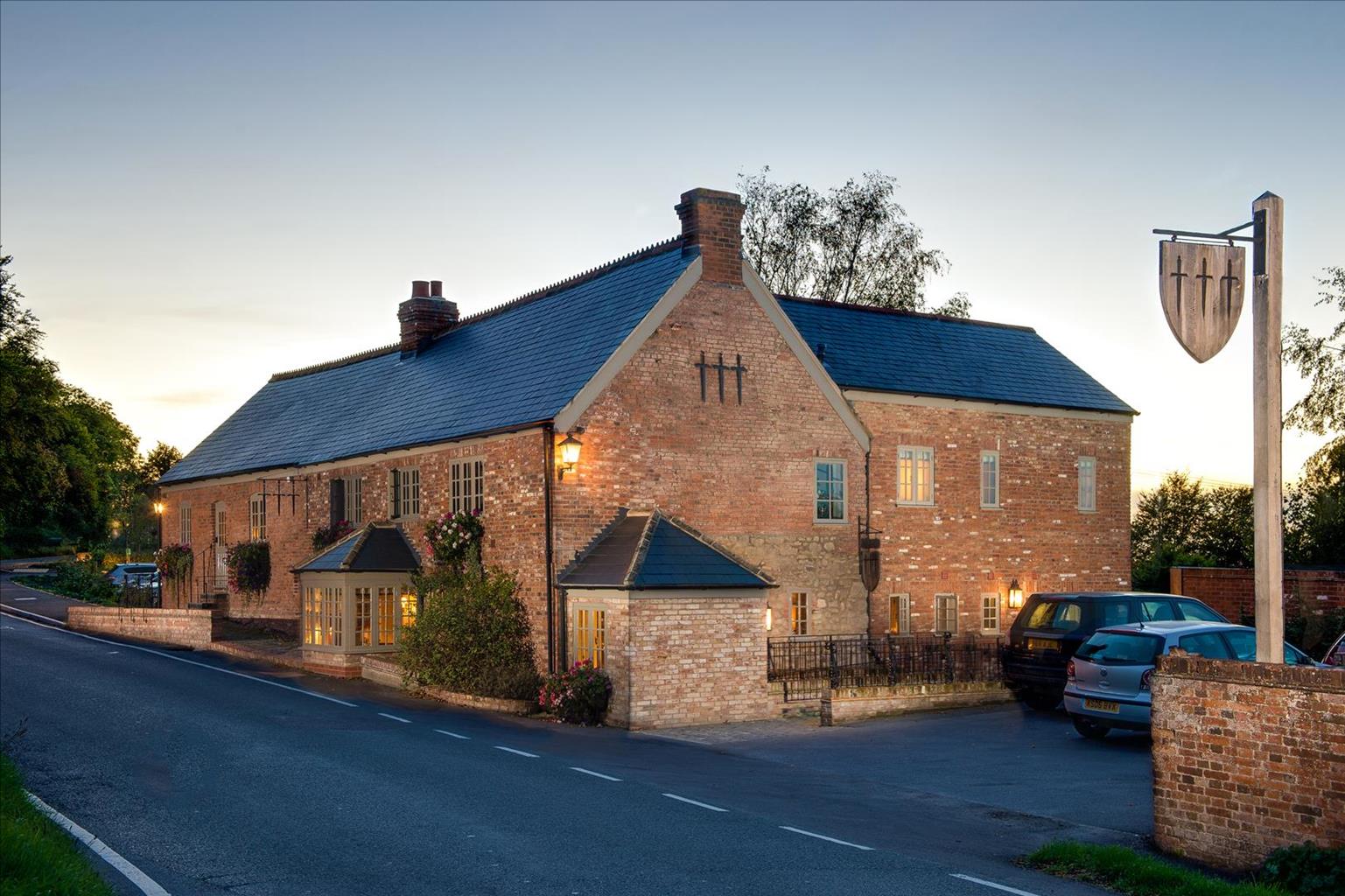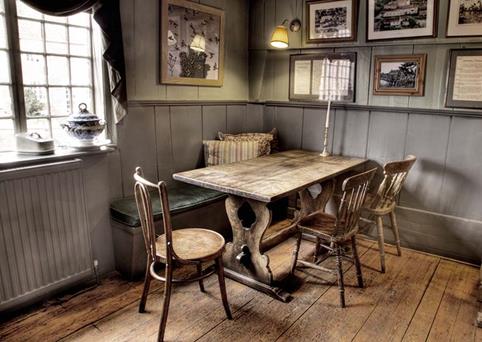Three Daggers is a nine-room retreat in the village of Edington. The three bedrooms at The Inn,…
Westbury White Horse

4.25 miles (6.8kms)
About the walk
The most notable feature of Bratton, a large village in the shadow of a huge downland escarpment, is the Church of St James, arguably one of the most charming churches in the county. Reached by a series of steep steps, and nestling at the base of the chalk downland, it dates from about 1400 and is worth the climb to view the traces of Norman architecture and the wildly grinning gargoyles.
Angels playing musical instruments
The church looks magnificent, standing among the trees and set against this dramatic downland backdrop. The architecture is particularly striking; the arcades rest on clustered columns and the north transept has angels playing musical instruments or carrying shields. Among many other fascinating features is a stair turret. Looming above Bratton is Westbury Hill, which rises to a commanding height of 750ft (229m) above sea level and forms the dramatic western edge of Salisbury Plain. The views are tremendous, with the scarp slope dropping into the Vale of Pewsey, and on the horizon, on a clear day, you can see across Somerset to the Mendips and the Cotswolds. Dominating the hilltop is Bratton Castle, an Iron Age hill-fort covering 25 acres (10ha) of the plateau and defended by double banks and ditches rising to 35ft (11m). The long barrow inside the fort is a burial mound probably built before 3000 BC.
Spirit of a horse
Cut into the side of the hill, just below the castle ramparts, is Wiltshire’s oldest and best known white horse, measuring 180ft (55m) long and 108ft (33m) high. This graceful hill figure is believed to have replaced a much earlier and cruder creature which local tradition states was cut in celebration of King Alfred’s victory over the Danes at the Battle of Ethundun in AD 878. The present, well-proportioned animal, which is featured on the bottles of a brand of whisky of the same name, was cut by a Mr Gee, steward to Lord Abingdon, in 1778, apparently because he objected to the primitive dog-like creature which had previously existed on Westbury Hill. The White Horse was remodelled in 1853 and restored 20 years later, with its most recent makeover in concrete, courtesy of Westbury Cement Works (the unmistakable industrial complex you can see in the valley below).
Striking landmarks
The south of England is renowned for its white horse chalk carvings. Up to 24 have been recorded in Britain with as many as 13 of them in Wiltshire at one time. Eight are still visible in the county, so it is hardly surprising that a long-distance trail has been created to link them all. The remaining carvings have been worn away by the passage of time or are hidden under turf, which has grown over them over the years. The Westbury White Horse is generally considered to be one of the best chalk carvings thanks to its striking position. The hilltop figures are usually created by the removal of the top layer of rather poor soil. This then reveals the white chalk beneath, which tends to contrast well with the short hill turf surrounding it. The result is particularly effective when the image is seen from some distance away.
Walk directions
Turn right out of the car park to the B3098. Turn left, then almost immediately left again up The Butts. Fork right into Upper Garston Lane by the Oratory of St Giles, then, just before the lane dips, take the path left, waymarked to the church. Descend steps, cross a brook, then climb steps to the church gates. Take the narrow path right and ascend through trees.
When you reach a kissing gate on your left, turn right along a waymarked path; go through a kissing gate and bear left between lines of trees, climbing steeply up the scarp slope to the fence at the top. Keep right alongside the fence, continue through a gate, then turn right through a metal gate to follow a sunken track around the top of Combe Bottom. At the lane, turn left uphill and, as the lane bears left, fork right over a stile on to the outer rampart of Bratton Camp. Turn right to follow the outer rampart path to reach the Westbury White Horse hill figure.
Shortly, leave the rampart and pass through a gate on to Westbury Hill. Keep to the path, passing to the left of benches, and soon reach a track. Turn left, pass the car park and turn right at the T-junction. Pass White Horse Farm, a collection of barns, and turn left along the track, following the Imber Range Perimeter Path. Keep to the track, passing a bridleway on the left, and continue to the next waymarked bridleway, by galvanized gates.
Turn left here, follow the main track past a copse into a field and keep to the left-hand edge to a gate. Go through it and bear right, descending steeply on a sunken track towards Bratton. Go through a gate and drop down through trees, keeping ahead on reaching a metalled lane.
Turn left at the T-junction, then bear left up a cobbled path (The Ball) between cottages. At the road, keep left back to the hall and car park where the walk started.
Additional information
Field paths and downland tracks
Downland
On leads near grazing animals on Combe Bottom, Bratton Camp and Westbury Hill
OS Explorer 143 Warminster & Trowbridge
Jubilee Hall in Tynings Lane, Bratton, just off B3098
None on route
WALKING IN SAFETY
Read our tips to look after yourself and the environment when following this walk.
Find out more
Also in the area
About the area
Discover Wiltshire
A land shrouded in mystery, myth and legend, Wiltshire evokes images of ancient stone circles, white chalk horses carved into hillsides, crop circles and the forbidden, empty landscape of Salisbury Plain. To many M4 and A303 drivers heading out of London through the clutter of the Thames Valley, Wiltshire is where the landscape opens out and rural England begins.
Wiltshire’s charm lies in the beauty of its countryside. The expansive chalk landscapes of the Marlborough and Pewsey downs and Cranborne Chase inspire a sense of space and freedom, offering miles of uninterrupted views deep into Dorset, Somerset and the Cotswolds. Wiltshire’s thriving market towns and picturesque villages provide worthwhile visits and welcome diversions. Stroll through quaint timbered and thatched villages in the southern Woodford and Avon valleys and explore the historic streets of the stone villages of Lacock, Castle Combe and Sherston. Walk around Salisbury and discover architectural styles from the 13th century to the present and take time to visit the city’s elegant cathedral and fascinating museums. And if all of that isn’t enough, the county is also richly endowed with manor houses, mansions and beautiful gardens.
Nearby stays
Restaurants and Pubs
Nearby experiences
Recommended things to do
Why choose Rated Trips?
Your trusted guide to rated places across the UK
The best coverage
Discover more than 15,000 professionally rated places to stay, eat and visit from across the UK and Ireland.
Quality assured
Choose a place to stay safe in the knowledge that it has been expertly assessed by trained assessors.
Plan your next trip
Search by location or the type of place you're visiting to find your next ideal holiday experience.
Travel inspiration
Read our articles, city guides and recommended things to do for inspiration. We're here to help you explore the UK.















